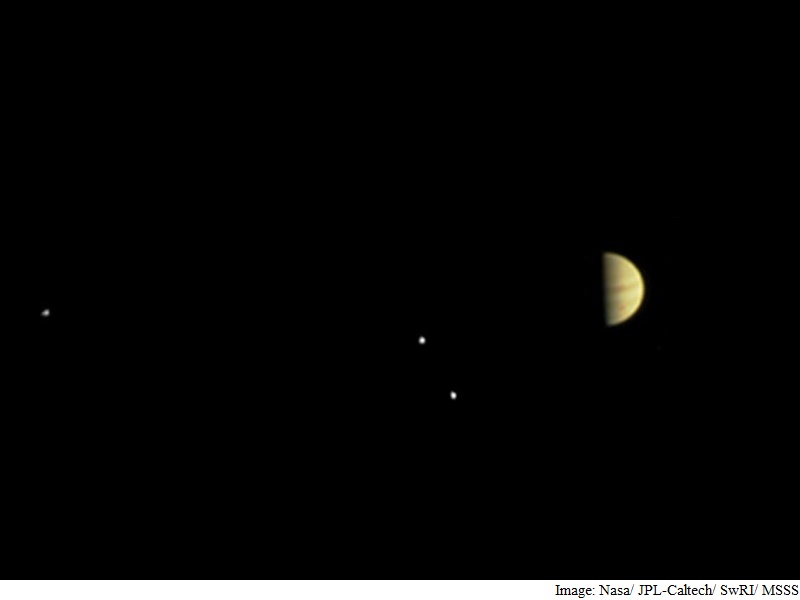- Home
- Science
- Science News
- Nasa's Juno Mission Enters Jupiter's Magnetic Field
Nasa's Juno Mission Enters Jupiter's Magnetic Field
By Indo-Asian News Service | Updated: 1 July 2016 17:23 IST

Advertisement
Nasa's Jupiter-bound Juno spacecraft has entered the planet's magnetosphere, where the movement of particles in space is controlled by what's going on inside Jupiter.
Juno is on course to swing into orbit around Jupiter on July 4.
"We've just crossed the boundary into Jupiter's home turf. We're closing in fast on the planet itself and already gaining valuable data," said Scott Bolton, Juno principal investigator, from Southwest Research Institute, San Antonio, in a statement on Thursday.
Science instruments on board detected changes in the particles and fields around the spacecraft as it passed from an environment dominated by the interplanetary solar wind into Jupiter's magnetosphere.
The obstacle is Jupiter's magnetosphere, which is the largest structure in the solar system.
"If Jupiter's magnetosphere glowed in visible light, it would be twice the size of the full moon as seen from Earth," Kurth said.
Out in the solar wind a few days ago, Juno was speeding through an environment that has about 16 particles per cubic inch (one per cubic centimetre).
Once it crossed into the magnetosphere, the density was about a hundredfold less.
The density is expected to climb again, inside the magnetosphere, as the spacecraft gets closer to Jupiter itself.
The motions of these particles travelling under the control of Jupiter's magnetic field will be one type of evidence Juno examines for clues about Jupiter's deep interior.
The Juno spacecraft was launched from Cape Canaveral, Florida, on August 5, 2011,
Juno is on course to swing into orbit around Jupiter on July 4.
"We've just crossed the boundary into Jupiter's home turf. We're closing in fast on the planet itself and already gaining valuable data," said Scott Bolton, Juno principal investigator, from Southwest Research Institute, San Antonio, in a statement on Thursday.
Science instruments on board detected changes in the particles and fields around the spacecraft as it passed from an environment dominated by the interplanetary solar wind into Jupiter's magnetosphere.
The obstacle is Jupiter's magnetosphere, which is the largest structure in the solar system.
"If Jupiter's magnetosphere glowed in visible light, it would be twice the size of the full moon as seen from Earth," Kurth said.
Out in the solar wind a few days ago, Juno was speeding through an environment that has about 16 particles per cubic inch (one per cubic centimetre).
Once it crossed into the magnetosphere, the density was about a hundredfold less.
The density is expected to climb again, inside the magnetosphere, as the spacecraft gets closer to Jupiter itself.
The motions of these particles travelling under the control of Jupiter's magnetic field will be one type of evidence Juno examines for clues about Jupiter's deep interior.
The Juno spacecraft was launched from Cape Canaveral, Florida, on August 5, 2011,
Comments
For the latest tech news and reviews, follow Gadgets 360 on X, Facebook, WhatsApp, Threads and Google News. For the latest videos on gadgets and tech, subscribe to our YouTube channel. If you want to know everything about top influencers, follow our in-house Who'sThat360 on Instagram and YouTube.
Related Stories
Popular on Gadgets
- Samsung Galaxy Unpacked 2025
- ChatGPT
- Redmi Note 14 Pro+
- iPhone 16
- Apple Vision Pro
- Oneplus 12
- OnePlus Nord CE 3 Lite 5G
- iPhone 13
- Xiaomi 14 Pro
- Oppo Find N3
- Tecno Spark Go (2023)
- Realme V30
- Best Phones Under 25000
- Samsung Galaxy S24 Series
- Cryptocurrency
- iQoo 12
- Samsung Galaxy S24 Ultra
- Giottus
- Samsung Galaxy Z Flip 5
- Apple 'Scary Fast'
- Housefull 5
- GoPro Hero 12 Black Review
- Invincible Season 2
- JioGlass
- HD Ready TV
- Laptop Under 50000
- Smartwatch Under 10000
- Latest Mobile Phones
- Compare Phones
Latest Gadgets
- Moto G15 Power
- Moto G15
- Realme 14x 5G
- Poco M7 Pro 5G
- Poco C75 5G
- Vivo Y300 (China)
- HMD Arc
- Lava Blaze Duo 5G
- Asus Zenbook S 14
- MacBook Pro 16-inch (M4 Max, 2024)
- Honor Pad V9
- Tecno Megapad 11
- Redmi Watch 5
- Huawei Watch Ultimate Design
- Sony 65 Inches Ultra HD (4K) LED Smart TV (KD-65X74L)
- TCL 55 Inches Ultra HD (4K) LED Smart TV (55C61B)
- Sony PlayStation 5 Pro
- Sony PlayStation 5 Slim Digital Edition
- Blue Star 1.5 Ton 3 Star Inverter Split AC (IC318DNUHC)
- Blue Star 1.5 Ton 3 Star Inverter Split AC (IA318VKU)
© Copyright Red Pixels Ventures Limited 2024. All rights reserved.

















